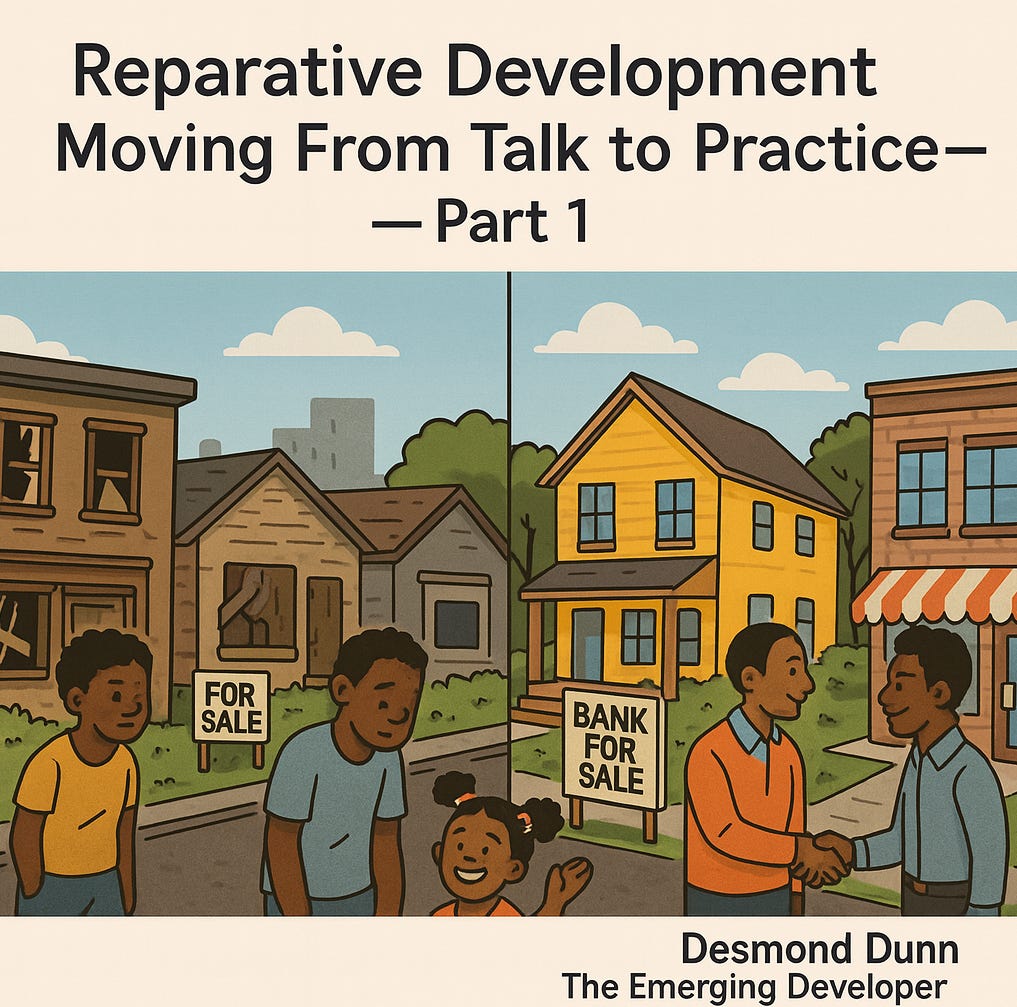The word reparations often sparks debate. But in housing and development, it isn’t just theory, it’s history. And it should be practice.
Across the country, Black families and communities lost land, wealth, and stability through redlining, urban renewal, and discriminatory lending practices. Those policies were intentional. The disinvestment was systematic. Which means repair must also be intentional and systematic.
Too often, though, the conversation around reparations in housing stays abstract. Good intentions. Symbolic statements. Occasional policy gestures. What’s missing is a clear, actionable framework for reparative development, practices that restore what was taken and create a more equitable future.
What Reparative Development Could Look Like
1. Free or Discounted Land Transfers
Cities and counties hold significant amounts of land, much of it acquired during urban renewal or through tax foreclosure. Instead of selling that land to the highest bidder, municipalities could transfer parcels to community land trusts, mission-driven developers, or directly to legacy residents at no or low cost. Land is wealth. Giving it back is repair.
2. Zero-Interest or Forgivable Loans
Financing has always been a gatekeeper. Black and Brown families were denied FHA loans that built the white middle class (NCRC). Today, underwriting standards still lock out small-scale developers and low-income homeowners. Public and philanthropic funds could provide zero-interest loans or forgivable financing to support ownership, renovation, and small-scale development.
3. Legacy Resident Protections
Repair isn’t just about the past. It’s about protecting the future. Development in historically Black neighborhoods often accelerates displacement. Reparative practice means embedding protections: tax relief for long-time residents, first-right-to-purchase programs, and policies that ensure legacy residents benefit from rising values rather than being pushed out.
Real-World Examples of Reparative Development in Action
Evanston, Illinois – Local Reparations for Housing
In 2021, Evanston launched the first publicly funded reparations program for housing in the U.S.
Black residents who lived in the city between 1919 and 1969, or their descendants, are eligible for up to $25,000 for home repairs or down payments.
Funded by cannabis tax revenue, it signals a shift toward actionable equity. (NBC News)
Palm Springs, California – A $27M Reparations Settlement
Palm Springs recently approved a $27 million settlement for over 300 Black and Latino families displaced in the 1960s.
Funds support mortgages, first-time homebuyers, a community land trust, and small business diversity.
One of the most comprehensive municipal reparations efforts to date. (Politico)
Tulsa, Oklahoma – Reparative Trust for Greenwood
Tulsa is advancing a $105 million reparations plan for descendants of the 1921 Race Massacre.
$24M for affordable housing
$60M for historic preservation
$21M for scholarships and small business grants
Administered through the Greenwood Trust, this represents a shift from apology to action. (Washington Post)
Dudley Street Neighborhood Initiative, Boston – CLT in Action
The Dudley Street Neighborhood Trust preserves over 30 acres of land.
Includes 200+ homes, businesses, gardens, and more.
Developed without displacement and designed by residents, it’s a living model of repair through design and ownership. (DSNI)
Why This Matters
Reparative development is not charity. It is correction. It acknowledges that the racial wealth gap in housing was created by policy and practice, and that only policy and practice can close it.
It also reframes what development is for. Not extraction. Not just growth. But repair, reinvestment, and restoration.
If we take this seriously, we can stop treating reparations as an impossible ideal and start seeing them as a practical framework for equity.
Moving From Talk to Practice
The conversation around reparations can feel heavy, even paralyzing. But in housing, there are immediate steps cities, institutions, and developers can take:
Audit public land holdings and prioritize transfers to community-rooted organizations
Create financing tools that level the playing field for small and BIPOC developers
Build displacement protections into every public-private partnership
These are not radical moves. They are overdue.
Reparative development asks us to look at the damage done by past policies and commit to doing the opposite. Instead of displacing, we protect. Instead of extracting, we invest. Instead of erasing, we restore.
Because if the harm was intentional, the repair must be intentional too.
What’s one reparative practice you’d like to see your city adopt today?


